 4th Sep 2024
4th Sep 2024
What Muscle Groups are Most Likely to Become Tight? And How to Effectively Stretch them!
In years gone by it was mostly acknowledged that middle aged and older folks were the ones who were primarily going to experience muscle tightness and a loss of joint range of motion (flexibility). After all, as people age many tend to reduce, some significantly, the amount and vigor of exercise they engage in and therefore the range of motion through which they move the joints of their limbs or trunk. Unfortunately, data also shows that today’s youth as a whole, are engaging in lesser amounts of exercise, are sitting longer, and are placing themselves in positions that compromise proper posture. This is contributing to muscle imbalances and the associated loss of range of motion and even postural deviations. For example, how many of our youth do we see positioned slumped forward holding and viewing their cellphones or working on their computers in a forward head and rounded shoulders posture? The consequence of this is that some muscles will become weak and other muscles become tight, producing a loss of balance between antagonistic muscle groups that would normally and appropriately “oppose” the tonicity pull of each other keeping the body in proper alignment.
If in the course a day a person repeatedly moves a joint through a good range of motion (whether that be through planned exercise or their routine activities of daily living), their muscles and other connective tissues are subjected to the stimulus that will help maintain their length and minimize nervous system tonic reflex activity. (It should be stated here that there is currently research and discussion on exactly how or if stretching affects muscle length and/or its impact on the nervous system to modulate the firing of pain signals in stiff muscles.)
Regardless, stretching is associated with greater range of motion (flexibility) and therefore greater mobility, reduced risk for muscle injury and pain, reduced pain associated with abnormal/unbalanced pressures placed on joints due to associated postural deviations, and the potentially negative cosmetics and emotional impact of postural deviations.
What body muscle groups are more likely to become tight, and why?
This question can be more effectively answered by addressing the “ abnormal postural positions” that are more prevalent today which negatively affect muscle strength and flexibility and other connective tissue and contribute to the adverse consequences mentioned above .
It is noted here that with these postural deviations, in addition to certain muscles becoming tight requiring stretching, other muscles become weak and require strengthening. As such, the weak muscles would therefore need to be strengthened as part of an overall intervention to help correct the postural deviation . However, the focus of this article is to identify the muscle groups that are tight and how to effectively stretch them .
| Upper Crossed Syndrome (UCS) |
The thoracic kyphotic, cervical lordotic and forward head (atlanto-occipital joint) hyper-extension position of Upper Crossed Syndrome may be the consequence of routinely sitting or standing with poor posture over time. The characteristic hunch of the upper back (thoracic kyphosis) and associated forward head (cervical lordosis) and rounded shoulders can often be observed when individuals are working on a computer, texting on a cellphone, or simply being lazy in neglecting the old adage to “sit up straight – chest out and head reaching toward the ceiling.” All of these postural deviations can lead to a lack of proper muscle strength and flexibility balance between antagonistic muscle groups on the dorsal/posterior and ventral/anterior sides of the body as shown below.

How to stretch the tight pectoral muscles, upper trapezius & levator scapula, and sub-occipital muscles (not identified in the above illustration, but should be)
Tight Pectorals
1. Pectoralis Major (both sternal and clavicular heads) : The best position in which to stretch both these muscles is to have the shoulder joint in a 90° abducted position, fully externally rotated, and horizontally abducted position. In these positions, place the arm against an immoveable structure. This can be effectively accomplished by assuming this shoulder position using a door frame to hold the shoulder in the above described position and then rotate the body away from the door frame as shown below.
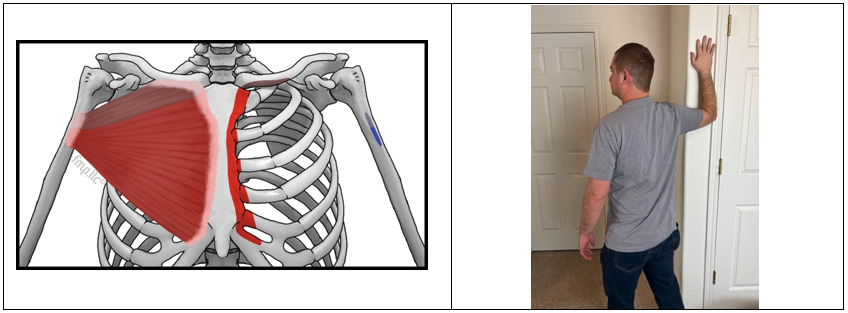
2.Pectoralis Minor: The best position in which to stretch this muscle is to have the arm fully flexed overhead and positioned against an immoveable structure. This can be effectively accomplished by assuming this shoulder position using a door frame to hold the shoulder in the described position and then r otate the body away from the door frame as shown below.
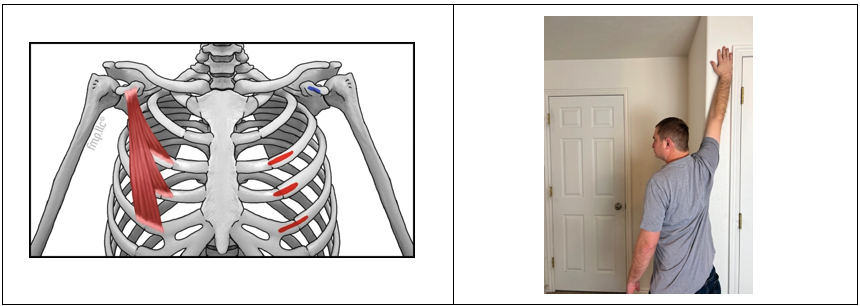
Tight Upper Trapezius and Levator Scapula (both scapular elevator muscles)
1.Upper Trapezius: The best position in which to stretch this muscle is to place the neck in the flexed position, laterally flexed to the opposite side of the muscle being stretched and rotated toward to side of the muscle being stretched as shown below.
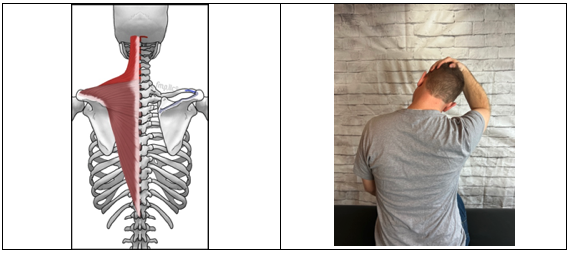
2.Levator Scapula: The best position in which to stretch this muscle is to place the neck in the flexed position, laterally flexed to the opposite side of the muscle being stretched and rotated away from the side of the muscle being stretched as shown below.
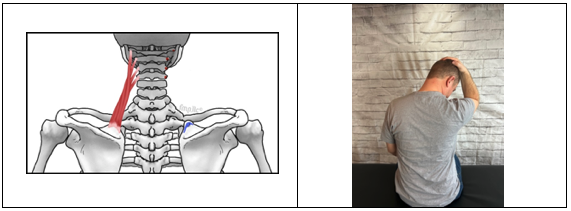
Tight Sub-occipitals: The best way to stretch this muscle group is to simply tuck your chin to your chest. Don’t flex your neck downward to touch your chin to your chest, rather, simply keep your head/neck straight while pulling your chin inward. You can even assist by pushing inward on your chin to help increase the stretch. You can perform this stretch when lying down face-up and press the back of your head into a padded table/floor. Again, keeping the head/neck straight, not flexed.
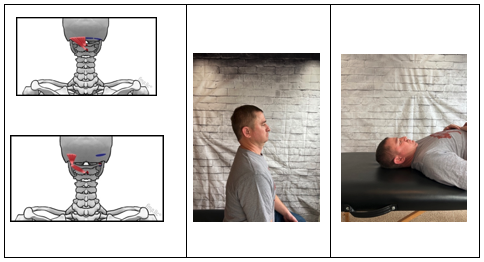
| Lower Crossed Syndrome |
This postural deviation involves a hyper-lordotic lumbar spine associated with an anterior pelvic tilt position which produces a forward positioned abdomen. One of the key reasons for the development of this condition is a weakness of the abdominal muscle group. Consider that during the course of a day we are often standing upright. Because the body’s center of mass is anterior to the spinal column, a person contracts/works their back extensor muscle group (erector spinae) to remain upright. So, they are almost constantly working. Now consider the abdominal muscles in the front. They need not contract/work to maintain an upright position. Further, we don’t use the abdominal muscles a lot during daily activities, not nearly to the degree we use our back muscles. Unless we consciously exercise them as part of a daily workout routine (or are engaged in sporting events that stress/work the abdominals), they just aren’t worked that much. Consequently, they weaken and become diminished in providing the needed counterforce to pull the pelvis upward in front, producing a posterior pelvic tilt position , working in opposition to the low back extensor muscle group.
Also contributing to this syndrome, is that we tend to sit a lot. The sitting position (hip flexion) places the hip flexor muscles in a shortened position where they become tight overtime if not routinely stretched. Another good reason to not sit too long at any one time. As you can see in the illustration below, tight hip flexors and back extensors are the muscles that are tight in lower crossed syndrome.
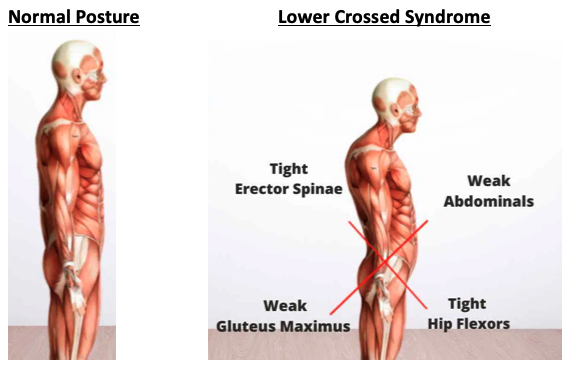
How to stretch the tight erector spinae (back extensors) and hip flexor muscle groups
Tight Back Extensors (Erector Spinae)
The best position in which to stretch the back extensor muscles is to place the trunk/lumbar area in flexion while also having the hip and knees in the flexed position. This will help eliminate the tension in the hamstrings when flexing the hip and allow the focus of the stretch to be on the low back muscles. This can be accomplished in a variety of ways as shown below. Another good stretch of the low back extensor is to lean downward while sitting, letting your body sink between your legs.
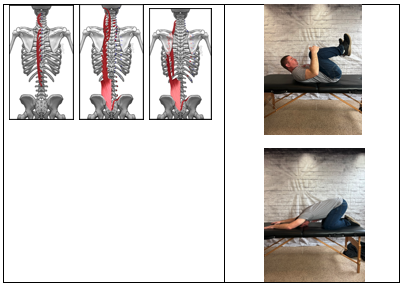
Tight Hip Flexors (Iliacus, psoas manor, rectus femoris)
The best position in which to stretch the hip flexor muscles is to place the hip in the extended position and the knee in the flexed position (so that the rectus femoris muscle will also be effectively stretched). This can be accomplished as shown below.
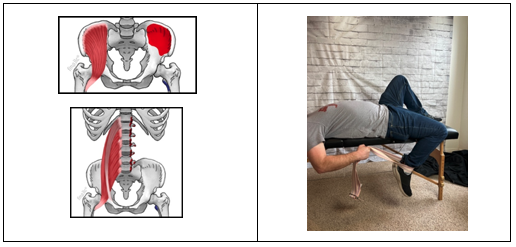
Other muscles groups that are at increased risk of becoming tight and need to be stretched
Hamstrings
Just as the hip flexor muscle group is prone to losing flexibility and becoming tight as a result of excessive sitting (hips in flexed position), the hamstrings are also prone to lose flexibility and become tight due to sitting (knees in flexed position).
The best position to stretch the hamstrings is hip flexion and knee extension (and keeping the ankle in a plantarflexed position so its tension does not limit knee extension). This can be accomplished in a variety of ways as shown below.
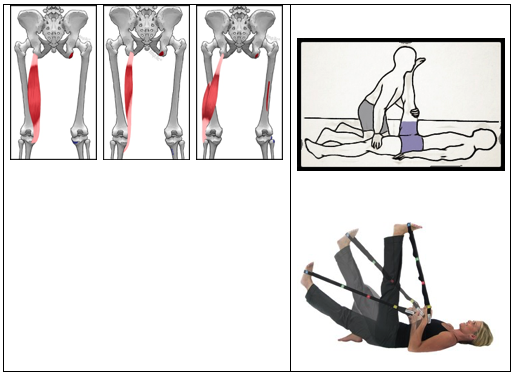
Calves
Sometimes, and for various reasons, we simply do not take our ankle joint through sufficient range of motion, and this can lead to the development of tightness in the gastrocnemius and soleus muscles. Maybe a lack of walking stride length so that insufficient hip extension occurs that would then limit the amount of dorsiflexion that normally occurs while walking. If a person rarely walks upstairs the ankles are not being placed in dorsiflexion.
The best position to stretch the calf muscles (plantar flexors) is ankle dorsiflexion combined with knee extension (to focus on the gastrocnemius) or knee flexion (to focus on the soleus) as shown below.
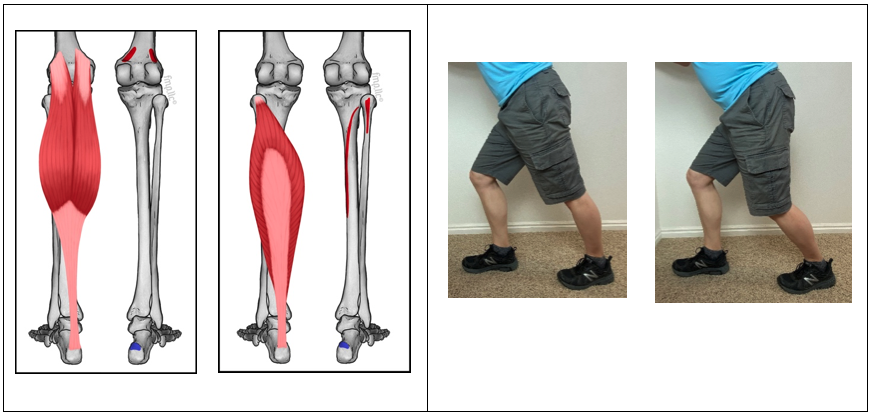
Tensor Fascia Latae
This individual muscle, if it becomes tight, can lead to a condition called IT Band Syndrome and result in pain around the lateral knee area where the IT band component of the tensor fascia latae muscle crosses the knee joint.
A good position in which to stretch this muscle is hip extension (or flexion), external rotation, and adduction as shown below.
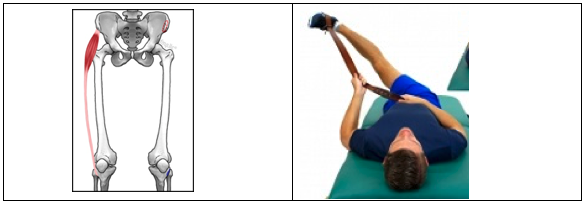
There can be various reasons for which a person experiences non-traumatic injury joint pain, such as arthritis, excessive body weight, etc. However, a significant reason can be contributed to joints that have unbalanced (from normal) weight application and therefore abnormal pressure placed on them as occurs with postural deviations.
As you can see from the information presented above in this article, many of these stretches can be performed without the need for assistive devices. However, sometimes an assistive device can make performing the stretch easier or enable the person to perform the stretch by themselves without the need for a partner stretch. Below are some devices that are often used to assist stretching of certain of these muscle groups should you desire the assistance. Success to you in your efforts to increase your flexibility, improve your posture, and prevent or rehabilitate the pain that can be associated with the postural deviations.





